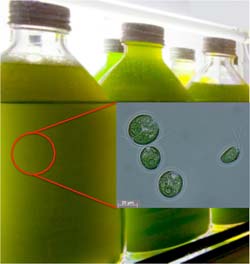A Temporary storage for electrons

The green algae Chlamydomonas reinhardtii, from which the investigated [FeFe]-Hydrogenase was isolated<br>Foto: MPI CEC/RUB<br>
Thus, it can very efficiently produce hydrogen, which has great potential as a renewable energy source. The research team describes their results in the journal “Angewandte Chemie”.
Producing hydrogen with enzymes
The system analysed constitutes an enzyme that catalyses the formation and conversion of hydrogen. In its centre it has a double-iron core, and is therefore also called [FeFe] hydrogenase. Hydrogenases are of great interest for energy research, since they can efficiently produce hydrogen. However, new catalysts can only be developed given a deep understanding of their mode of action.
Electron transfer in several steps
In hydrogen production, two electrons get together with two protons. The research team showed that, as expected, the first electron is initially transferred to the iron centre of the enzyme. The second transfer on the other hand is to an iron-sulphur cluster that is located in the periphery. It thus forms a temporary storage for the second electron. This “super-reduced” state may be responsible for the extremely high efficiency of the hydrogenase. Subsequently both electrons are transferred in one step from the enzyme to the protons, so that hydrogen is generated. “Only the use of two different spectroscopic techniques made the discovery possible”, says Agnieszka Adamska, a doctoral student at MPI CEC who carried out the spectroscopic studies.
10,000 molecules of hydrogen per second
“Up to 10,000 molecules of hydrogen per second can be generated by a single [FeFe] centre”, says Camilla Lambertz, a postdoc at the RUB who prepared the biological samples for the project. The enzyme is thus among the most efficient hydrogenases and is therefore also being intensively investigated by biologists and chemists with a view to achieving environmentally friendly hydrogen production. The complete mechanism of hydrogen formation is, however, complex and several steps need to be clarified. Next, the researchers at MPI CEC and the Ruhr-Universität Bochum aim to use sensitive spectroscopic methods to locate the proton to which the two electrons are transferred. This negatively charged hydrogen atom (hydride) reacts with another proton to form hydrogen. Inspired by the [FeFe] hydrogenase, the researchers would like to develop their own hydrogen-producing catalysts that could be used for the generation of hydrogen.
Information about MPI CEC
The Max Planck Institute for Chemical Energy Conversion (MPI CEC) in Muelheim an der Ruhr focuses on fundamental chemical reactions, that play key roles for the storage and conversion of energy. The main objective is to store the energy provided by sunlight in small, energy rich molecules, and thus make it readily accessible independent of time and location. 75 scientists from more than 20 countries work in the three departments Heterogeneous Reactions, Molecular Theory and Spectroscopy and Biophysical Chemistry. The combination of their respective expertise contributes to the development of a sustainable energy concept.
Further information
Dr. Rebekka Loschen, Max Planck Institute for Chemical Energy Conversion,
Public Relations, 45470 Mülheim a.d.Ruhr, 0208/3063681
Bibliographic record
A. Adamska, A. Silakov, C. Lambertz, O. Rüdiger, T. Happe, E. Reijerse, W. Lubitz (2012): Identification and Characterization of the “Super-Reduced” State of the H-Cluster in [FeFe] Hydrogenase: A New Building Block for the Catalytic Cycle?, Angewandte Chemie International Edition, doi: 10.1002/anie.201204800
Media Contact
All latest news from the category: Life Sciences and Chemistry
Articles and reports from the Life Sciences and chemistry area deal with applied and basic research into modern biology, chemistry and human medicine.
Valuable information can be found on a range of life sciences fields including bacteriology, biochemistry, bionics, bioinformatics, biophysics, biotechnology, genetics, geobotany, human biology, marine biology, microbiology, molecular biology, cellular biology, zoology, bioinorganic chemistry, microchemistry and environmental chemistry.
Newest articles

Silicon Carbide Innovation Alliance to drive industrial-scale semiconductor work
Known for its ability to withstand extreme environments and high voltages, silicon carbide (SiC) is a semiconducting material made up of silicon and carbon atoms arranged into crystals that is…

New SPECT/CT technique shows impressive biomarker identification
…offers increased access for prostate cancer patients. A novel SPECT/CT acquisition method can accurately detect radiopharmaceutical biodistribution in a convenient manner for prostate cancer patients, opening the door for more…

How 3D printers can give robots a soft touch
Soft skin coverings and touch sensors have emerged as a promising feature for robots that are both safer and more intuitive for human interaction, but they are expensive and difficult…





















